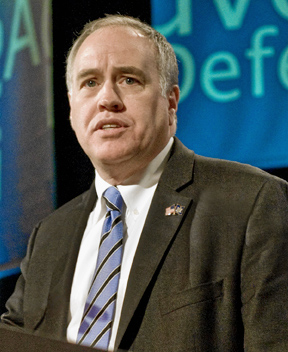
Two-term New York Comptroller Thomas DiNapoli is the sole trustee of New York’s largest pension funds, but he’s now facing competition from an unlikely source: a local auditor named Robert Antonacci who claims he is more qualified than DiNapoli.
From The Associated Press:
Democratic New York Comptroller Thomas DiNapoli, chief financial officer for the state, faces an election challenge from a little-known accountant and lawyer who does similar work for Onondaga County and says he’s more qualified.
Robert Antonacci said the power of the checkbook is the key to whether state programs — such as economic development projects — are delivering. The 49-year-old Republican also said that following the flow of money through politics is how you clean up corruption.
“You can really get into the engine of government from the experience I have,” Antonacci said. “We’re going to look at everything in terms of what makes New York state tick.”
State economic development efforts, seeding proposed business expansions with tax breaks, funding or other support in return for promised jobs, will be a big initiative if he’s elected, Antonacci said. The Cuomo administration’s Start-Up New York program is one place the comptroller should be looking and verifying data, he said.
“We’re going to start with the governor and the Legislature, not the village of Podunk,” he said, referring to the mission of the comptroller’s office to audit government entities small and large.
[…]
“When you talk about getting at the underbelly of how governments run, as a CPA I have 30 years of experience of understanding how business operates,” he said. “The data is the key, and when you’ve got a CPA looking at a financial statement it’s a lot different than somebody who doesn’t have that experience.”
Both candidates have addressed the state’s pension system, as managing the fund’s investments is a large part of the comptrollers job. From AP:
[DiNapoli’s] stewardship has helped New York’s pension fund for public workers rebound from the 2008 national recession and grow to a record $181 billion, with state and municipal contribution rates declining for 2015 and 2016, he said.
[…]
As for the state’s $180 billion pension fund, Antonacci said his goal will be maximizing the return to taxpayers and not shareholder activism.
DiNapoli, as the pension fund’s sole shareholder, has sponsored shareholder resolutions at large corporations calling for more complete disclosures of their political activities, environmental practices and workplace standards at the overseas factories of suppliers. DiNapoli said those measures help protect shareholders, their investments and the companies from potential risks.
The election will be held Nov. 4.
Photo by Awhill34 via Wikimedia Commons

